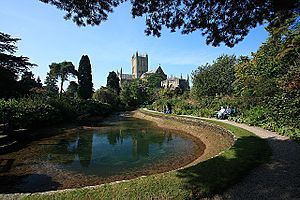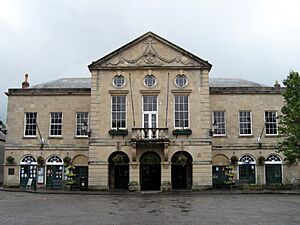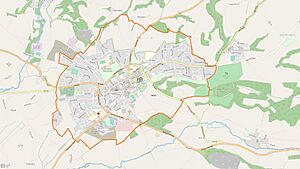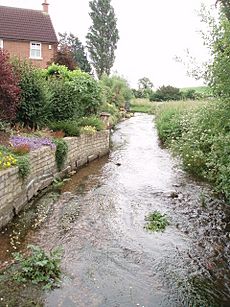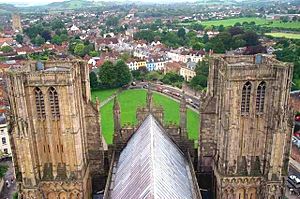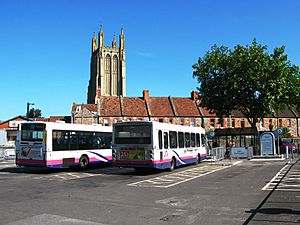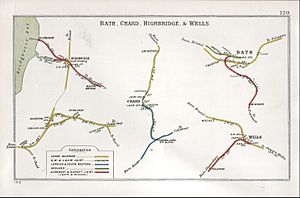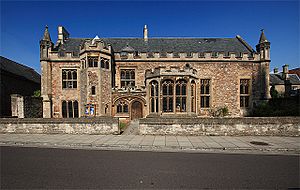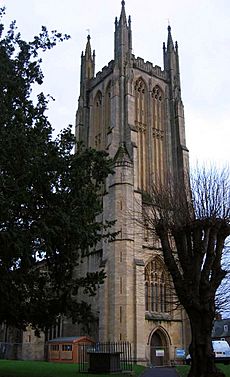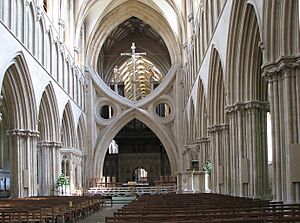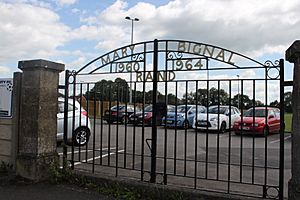Wells, Somerset facts for kids
Quick facts for kids Wells |
|
|---|---|
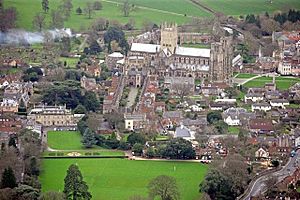 Aerial photograph of Wells |
|
| Population | 12,000 (2018) |
| OS grid reference | ST545455 |
| Civil parish |
|
| Unitary authority |
|
| Ceremonial county | |
| Region | |
| Country | England |
| Sovereign state | United Kingdom |
| Post town | WELLS |
| Postcode district | BA5 |
| Dialling code | 01749 |
| Police | Avon and Somerset |
| Fire | Devon and Somerset |
| Ambulance | South Western |
| EU Parliament | South West England |
| UK Parliament |
|
Wells is a beautiful city in Somerset, England. It sits at the edge of the Mendip Hills. Even though it's quite small, with about 12,000 people, Wells has been a city for a very long time. This is because it has a famous cathedral. People often call it England's smallest city. However, it's actually the second smallest in size and population, after the City of London. Unlike London, Wells is not part of a huge city area.
Wells got its name from three special wells (springs of water). These wells are dedicated to Saint Andrew. One is in the market square, and two are in the gardens of the Bishop's Palace and the cathedral. A small Roman settlement first grew around these wells. It became more important when Anglo-Saxons arrived. King Ine of Wessex built a church there in 704. Wells became a busy trading place, known for making cloth. It also played a part in the English Civil War and the Monmouth Rebellion in the 1600s. In the 1800s, Wells got railway lines, but these closed in 1964.
Today, many jobs in Wells are linked to the cathedral and its history. The city offers many sports and cultural activities. It also has several schools, including The Blue School, which started in 1641. Another is the Wells Cathedral School, founded around 909. This school is one of the top music schools for children in the UK. Wells's old buildings are so beautiful that they have been used as filming locations for many movies and TV shows.
Contents
- A Journey Through Wells' History
- How Wells is Governed
- What Makes Wells a City?
- Wells' Location and Climate
- People of Wells
- Wells' Economy and Tourism
- Getting Around Wells
- Schools in Wells
- Culture and Entertainment
- Local News and Media
- Religious Sites in Wells
- Sports in Wells
- Famous People from Wells
- Images for kids
- See also
A Journey Through Wells' History
Wells started as a Roman settlement. It grew into an important place under the Anglo-Saxons. King Ine of Wessex built a church here in 704. About 200 years later, in 909, Wells became the home of a new bishop. This meant it was a very important religious centre. However, in 1090, the bishop's main office moved to Bath.
This move caused arguments between the church leaders in Wells and the monks in Bath. Finally, in 1245, they agreed. The bishopric was renamed the Diocese of Bath and Wells. Both religious groups would choose the bishop. With the building of the current cathedral and the bishop's palace in the 1200s, Wells became the main religious centre again.
In the Middle Ages, Wells was a busy trading hub. A port nearby helped bring goods within a few miles of the city. By the 1300s, ships from France came up the river. People from Wells traded cloth and corn with Portugal for iron and salt. Wells was famous for making cloth. Even though this slowed down later, the city kept its important market. In the 1800s, Wells had the biggest cheese market in western England.
Wells was mentioned in the Domesday Book in 1086. It was called Welle, from an old English word for "wells." It was listed as four large farms, not a town, with about 132 families. This means around 500–600 people lived there.
Wells was given special rights to hold markets by Bishop Robert (1136–66). King John officially recognized Wells as a free town in 1201. The city was controlled by the bishop until Queen Elizabeth I gave it its own charter in 1589. Wells's city status was last confirmed by Queen Elizabeth II in 1974. This made the local area (called a civil parish) officially a city.
Royal Visits and Rebellions
Anne of Denmark, the wife of King James I, visited Wells on August 20, 1613. The town's workers put on a big show for her. Blacksmiths showed off a forge. Butchers created a funny scene with "old virgins" dressed in cow tails and horns. The mayor held a special dinner for the queen's guests. Everyone said she loved it!
During the English Civil War (1642–1651), Wells was surrounded by Parliamentarian soldiers. The Royalist army left the city. Parliamentarian troops then used the cathedral to keep their horses. They also damaged many of the beautiful statues by using them for target practice.
William Penn, who later founded Pennsylvania in America, stayed in Wells in 1682. He was briefly arrested for speaking to a crowd in the market. But the Bishop of Bath and Wells helped him get released. During the Monmouth Rebellion in 1685, rebel soldiers attacked the cathedral. They were angry at the official church. They damaged the west front, broke windows, and smashed the organ. They even used lead from the roof to make bullets.
Wells was the last place where the "Bloody Assizes" were held on September 23, 1685. In a quick court session that lasted only one day, over 500 men were put on trial. Most of them were sentenced to death.
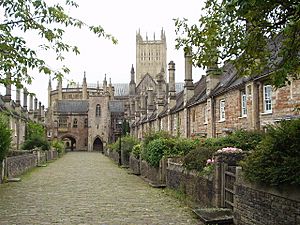
Wells had its first train station, Priory Road, in 1859. Later, two more railway lines opened, with stations at Wells East Somerset and Tucker Street. Eventually, the lines were connected, and some stations closed. By 1964, all passenger and goods train services to Wells had stopped. A famous steam train, named City of Wells, was used on the Golden Arrow service between London and Dover. It was saved from a scrapyard and can still be seen working on the East Lancashire Railway today.
During World War II, there were two prisoner-of-war camps in Wells. One held Italian prisoners, and another held German prisoners.
How Wells is Governed
Wells City Council is like a local government for the city. It has sixteen councillors who are elected from three areas: Central, St. Thomas's, and St. Cuthbert's.
The city of Wells became a "civil parish" in 1933. This means it's a local area with its own council. Since 1974, Wells has officially been a city. The person who leads the City Council is called the Mayor of Wells. This is a very old and important role. The current mayor (for 2020–21) is Councillor Philip Welch, who is the 647th Mayor of Wells! Another old role is the Town Crier, who makes announcements in the city.
The City Council helps with many local things. They set a local tax to pay for city services. They also look at plans for new buildings and work with the police to keep the city safe. They manage things in the city centre, like CCTV cameras and rules about street trading. They also organize funfairs in the Market Place twice a year and the "Wells in Bloom" flower competition.
The council also helps maintain city facilities. This includes working with the main county council on roads, drainage, and public transport. They are involved in managing the Community Sports Development Centre at the Blue School, the skateboard park, and community gardens called allotments. They also help protect old buildings and the environment.
The Wells Town Hall was built in 1778. It's a beautiful old building that is now a listed building. It used to be a court where important legal cases were heard.
Today, most other local government services are provided by Somerset Council. Wells is part of the Wells and Mendip Hills area for national government elections.
The city's official symbol shows an ash tree with three water wells around it. It has a Latin motto: Hoc fonte derivata copia, which means "the fullness that springs from this well."
Wells has "twinning" links with towns in other countries. It is twinned with Paray-le-Monial in France, Bad Dürkheim in Germany, and Fontanellato in Italy. These links help people from different countries learn about each other.
Some famous people and groups have been given the "Freedom of the City" of Wells. This is a special honour. These include Mary Rand, Danny Nightingale, The Rifles, and the late Harry Patch. The Somerset Light Infantry also received this honour in 1956.
What Makes Wells a City?
Wells is known as a city because it has a very old cathedral and a diocese (an area managed by a bishop). Queen Elizabeth II officially confirmed its city status in 1974. This means the local area, or civil parish, is officially the city of Wells.
Wells is one of the smallest cities in the UK in several ways:
- It's the smallest stand-alone city in the UK by area (2.11 square miles). The City of London is smaller, but it's part of the much larger Greater London.
- It's the second smallest in England and the UK by its council area.
- It's the second smallest in England by population and urban area.
- It's the fourth smallest in the UK by population and urban area, after St Davids, St Asaph, and the City of London.
Wells' Location and Climate
Wells is located at the bottom of the Mendip Hills. These hills are mostly made of carboniferous limestone, which is dug up in nearby quarries. The tallest TV mast in the area, the Mendip UHF television transmitter, is on Pen Hill above Wells.
Water from caves in the Mendip Hills flows out at Saint Andrew's Well, in the Bishop's Palace garden. This water fills the moat around the Palace. Then it flows into Keward Brook, which eventually joins the River Sheppey in the village of Coxley.
Like the rest of South West England, Wells has a mild climate. It's generally wetter and milder than other parts of England. The average temperature is about 10°C (50°F). January is the coldest month, and July and August are the warmest. It gets about 1600 hours of sunshine a year. It rains about 800–900 mm (31–35 inches) each year. Snowfall is typical for about 8–15 days. The wind usually blows from the south-west.
The area around Wells is called the parish of St Cuthbert Out.
People of Wells
The population of Wells was 10,536 in the 2011 census. Most people (97.5%) are White, and 66.5% said they were Christian. The average age in 2011 was 41.9 years old.
Wells' Economy and Tourism
After a new bypass road was built, the centre of Wells became a quiet market town again. It has modern shops, hotels, and restaurants. Wells is a popular place for tourists. People visit because of its historical sites and its closeness to other famous places like Bath, Bristol, Stonehenge, and Glastonbury. The Wookey Hole Caves, Mendip Hills, and Somerset Levels are also nearby. Famous Cheddar cheese is made locally.
The old parts of Wells are often used for filming movies and TV shows. This includes historical dramas and big productions. Recently (2014-2017), parts of Poldark, Dunkirk, and The White Princess were filmed here. The Bishop's Palace, Wells is especially popular for filming.
Getting Around Wells
Wells is where three main roads meet: the A39, the A371, and the B3139. The closest major highways are the M5 and M32.
Wells has bus services that go to nearby cities like Bristol, Bath, Frome, and Weston-super-Mare. There's also a daily bus service to London. The bus station is on Princes Road. Long-distance walking paths like the Mendip Way and Monarch's Way pass through the city. National Cycle Route 3 also goes through Wells.
Railways
Wells used to have two train stations, Wells (Tucker Street) railway station and Wells (Priory Road) railway station. But these were closed in the 1960s. The closest working railway line today is the East Somerset Railway, which is a heritage railway.
For national train services, the nearest station is Castle Cary, about 12 miles (19 km) away. You can also take a bus to Bristol Temple Meads railway station, which takes about an hour.
Schools in Wells
The Blue School was founded in 1641. It's a state school for boys and girls aged 11–18. It's known for its science programs.
Wells Cathedral School started in 909. It's a private school with a Christian focus. It's one of the five best music schools for children in Britain. Over 700 students aged 3 to 18 go there. The school's boarding houses are in the northern part of the city. The music school works closely with Wells Cathedral. The primary schools in Wells are Stoberry Park School, St Cuthbert's Church of England Infants School, St Cuthbert's Church of England Junior School, and St Joseph and St Teresa Catholic Primary School.
Culture and Entertainment
The Wells and Mendip Museum has many old items from the city and the nearby Mendip Hills. Wells is also part of the West Country Carnival circuit, which means it hosts a big, colourful parade.
The Wells Film Centre shows new movies. The Wells Film Society also shows older or less common films. There's also the Wells Little Theatre, which is run by volunteers. They put on plays and musicals in an old school building.
Milton Lodge is a house overlooking the city. It has a beautiful terraced garden from the early 1900s.
Local News and Media
You can watch local TV news from BBC West and ITV West Country. Local radio stations include BBC Radio Somerset, Heart West, and Greatest Hits Radio South West. Local newspapers that cover Wells are Wells Voice, The Somerset County Gazette, and SomersetLive.
Religious Sites in Wells
A special walled area, called the Liberty of St Andrew, holds the famous Cathedral, the Bishop's Palace, Vicars' Close, and homes for the clergy (church leaders). You can enter through old gatehouses like the Penniless Porch, The Bishop's Eye, and Brown's Gatehouse, all built around 1450.
The Church of St Cuthbert has a tall stone tower and a carved roof. It's a very old church, first built in the 1200s. The Church of St Thomas was built in 1856–1857. It honours Dean Richard Jenkyns, who helped the poor in the city.
Wells also has an Evangelical Church called Wells Vineyard Church, which started in 2003.
Wells Cathedral
Wells Cathedral is the main church for the Church of England in the Diocese of Bath and Wells. Wells has been an important church city since the early 700s. Parts of the cathedral are from the 900s. It's famous for its beautiful vaulted ceilings, the Lady Chapel, and its windows. The "scissor arches" inside are unique. They were built to support the heavy central tower. The west front of the cathedral has almost 300 original medieval statues. They are carved from a warm, yellow stone.
The Chapter House, reached by stone stairs, is an eight-sided building with a fan-vaulted ceiling. This is where the cathedral's leaders still meet to run things. The Wells Cathedral clock is famous for showing the time and stars. It also has jousting knights that appear every fifteen minutes. The cathedral has the heaviest set of ten bells in the world!
The Vicars' Close is the oldest street in Europe where people still live. It's designed to look longer from one end and shorter from the other. The Old Deanery is from the 1100s, and St John's Priory is from the 1300s. The cathedral owns this historic street.
The Bishop's Palace
The Bishop's Palace has been the home of the bishops of the Diocese of Bath and Wells for 800 years. The main hall and chapel were built in the 1300s. The palace has 14 acres (5.7 hectares) of gardens. These gardens include the springs that give Wells its name. Visitors can see the Bishop's private chapel, the ruins of the great hall, and the gatehouse. The gatehouse has a portcullis (a heavy gate) and a drawbridge. Next to it, mute swans ring a bell when they want food! The Bishop's Barn was built in the 1400s.
Sports in Wells
Wells has two football clubs: Wells City F.C., which has won the Western Football League, and Belrose FC. Wells Cricket Club has many teams for adults, juniors, and women. They play at South Horrington. Wells Wanderers Cricket Club is based in Meare. Rowdens Road Cricket Ground used to host professional cricket games. Now, part of it is used by Wells FC.
Mid-Somerset Hockey Club and Wells City Acorns Hockey Club both play on the artificial pitches at the Blue School. Many other sports clubs are also based there. The Wells Leisure Centre has a 25-metre (82 ft) swimming pool, a gym, a sports hall, and a sauna. The 18-hole Wells Golf Club is just outside the city. It also has a driving range where you can practice your golf swing.
Famous People from Wells
Many interesting people have connections to Wells:
- Hugh of Wells and Jocelin of Wells were brothers who became bishops. Jocelin helped create the Magna Carta and built much of the cathedral.
- Herbert E. Balch was a cave explorer who started the Wells Museum.
- Mary Bignall-Rand won a gold medal and set a world record in the long jump at the 1964 Olympics.
- Jack Buckner won gold and silver medals in running events in the 1980s.
- Harry George Crandon received the Victoria Cross for bravery during the Boer War.
- Alexander Davie was born in Wells in 1847 and later became the leader of British Columbia in Canada.
- Elizabeth Goudge was a famous author of novels and children's books, born in Wells in 1900.
- Roger Hollis was the head of MI5, a British intelligence agency.
- John Holloway was a governor of Newfoundland and an Admiral.
- John Keate was born in Wells in 1773 and became a strict headmaster at Eton.
- James Keene is a professional footballer.
- Kris Marshall is an actor who grew up and lives in Wells.
- Harry Patch was the last surviving soldier from the trenches of World War I. He lived to be 111 years old and was living in Wells when he passed away.
- Julia Somerville is a newsreader and journalist.
- Edgar Wright is a film director who directed Hot Fuzz, which was filmed in Wells.
Images for kids
See also
 In Spanish: Wells para niños
In Spanish: Wells para niños



